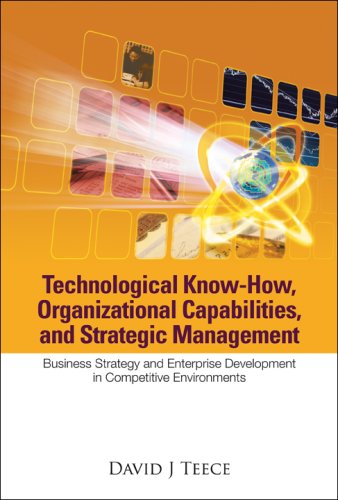

Most ebook files are in PDF format, so you can easily read them using various software such as Foxit Reader or directly on the Google Chrome browser.
Some ebook files are released by publishers in other formats such as .awz, .mobi, .epub, .fb2, etc. You may need to install specific software to read these formats on mobile/PC, such as Calibre.
Please read the tutorial at this link: https://ebookbell.com/faq
We offer FREE conversion to the popular formats you request; however, this may take some time. Therefore, right after payment, please email us, and we will try to provide the service as quickly as possible.
For some exceptional file formats or broken links (if any), please refrain from opening any disputes. Instead, email us first, and we will try to assist within a maximum of 6 hours.
EbookBell Team

5.0
68 reviews
ISBN 10: 9812568506
ISBN 13: 9789812568502
Author: Teece David J
This book explores factors which impact the viability and growth of business enterprises. In particular, the role of entrepreneurship, organizational learning, and business strategy — including licensing strategy — are considered in some detail. It presents fundamental thinking about business organization and provides the conceptual framework that scholars need to understand complex business organization, managerial processes, and competitive strategy.
Capturing Value from Knowledge Assets
1.1 Knowledge and Competitive Advantage
1.2 Liberalization of Markets
1.3 Expansion of What's Tradable
1.4 Strengthening of Intellectual Property Regimes
1.5 The Growing Importance of Increasing Returns
1.6 Decoupling of Information Flows from Goods and Services
1.7 Ramifications of New Information and Communications Technologies
1.8 Product Architecture and Technology Fusion
1.9 Implications
1.10 Capturing Value from Knowledge and Competence
1.11 The Nature of Knowledge
1.12 Replicability, Imitability, and Appropriability
1.13 Appropriability and Markets for Know-How and Competence
1.14 Sectoral Differences in the Market for Know-How
1.15 Complementary Assets
1.16 Dynamic Capabilities
1.17 Implications for the Theory of the Firm
1.18 Conclusion
Dynamic Capabilities and Strategic Management
2.1 Introduction
2.2 Models of Strategy Emphasizing Market Power
2.3 Models of Strategy Emphasizing Efficiency
2.4 The Dynamic Capabilities Approach
2.5 Toward a Dynamic Capabilities Framework
2.6 Markets and Strategic Capabilities
2.7 Replicability and Imitability of Organizational Processes
2.8 Conclusion
Dynamic Capabilities, Competence and the Behavioral Theory of the Firm
3.1 Introduction
3.2 The Behavioral Theory of the Firm
3.3 The Behavioral Theory and Strategy
3.4 The Behavioral Theory and Firm Competencies
3.5 The Behavioral Theory and Dynamic Capabilities
3.6 Conclusion
Dynamic Capabilities and Multinational Enterprise
4.1 Abstract and Key Results
4.2 Introduction
4.3 Resource-Based Theory of the Firm
4.4 Penrose and the Theory of Dynamic Capabilities
4.5 Growth Issues and the Penrose Effect
4.6 Entrepreneurship and Enterprise Design
4.7 Dynamic Capabilities and MNEs
4.8 Conclusion
Managers, Markets, and Dynamic Capabilities
5.1 Introduction
5.2 Understanding Fundamental Economic Problems
5.3 Asset Orchestration
5.4 Asset Orchestration Versus Coordination
5.5 Towards a Dynamic Capabilities Theory of the Firm
5.6 Conclusion
An Economics Perspective on Intellectual Capital
6.1 Introduction
6.2 Organizing R&D and Knowledge Production
6.3 Economics of Knowledge
6.4 Innovation and Economic Growth
6.5 Firm-Level Developments
6.6 Central Concepts
6.7 Capturing Value from Intellectual Capital
6.8 Measurement Issues
6.9 Conclusion
Technology and Technology Transfer
7.1 Introduction
7.2 Mansfield's Vision and Early Work
7.3 Economics of Technology Transfer
7.4 Elements of Received Wisdom
7.5 Capturing Value from Intellectual Capital
7.6 Valuation Issues
7.7 Multinational Firms and R&D
7.8 Closing
Collaborative Arrangements and Global Technology Strategy
8.1 Introduction
8.2 Organizational Dimensions of Technology Strategy
8.3 Forces Determining Technology Sourcing Strategies
8.4 External Procurement of Know-How
8.5 Accessing Complementary Assets
8.6 Governance of Collaborative Relationships
8.7 Conclusions
Firm Capabilities and Economic Development
9.1 Introduction
9.2 Competences and Capabilities
9.3 Processes, Positions, and Paths
9.4 Replicability and Imitability
9.5 Implications
9.6 Conclusion
A Review and Assessment of Organizational Learning
10.1 Orthodox Models
10.2 Behavioral Modifications
10.3 Institutional Modifications
10.4 Equilibrium Modifications
10.5 Learning and Innovation
10.6 Organizational Learning and Theories of the Firm
10.7 Summary
10.8 Conclusion
Research Directions for Knowledge Management
11.1 The Need for Transdisciplinary Enquiry
11.2 Research Issues
11.3 Quantifying Intangible Assets
11.4 Understanding Inputs and Profitability
11.5 Entrepreneurial vs. Administrative Capabilities
11.6 Reflections on the Berkeley Initiative
Capturing Value from Technological Innovation
12.1 Who Wins from Innovation?
12.2 Examples (EMI, RC Cola)
12.3 Patents and Practical Outcomes
12.4 Conclusion
Managing Intellectual Capital: Licensing and Cross-Licensing
13.1 Licensing Legacy
13.2 Cross-Licensing in Computer Industry
13.3 Licensing Practices in Semiconductors
13.4 Strategic Considerations
13.5 Managing Intellectual Capital in Electronics
13.6 Contrasting IP Management Objectives
13.7 Changing IP Modes
13.8 Lessons for Innovation Management
13.9 Policy Issues
13.10 Conclusion
Patents, Licensing, and Entrepreneurship
14.1 Introduction
14.2 Intellectual Property and Entrepreneurship
14.3 Multi-Invention Context
14.4 Understanding Patent Strategy
14.5 Entrepreneurship and Patent Strategy
14.6 Cross-Licensing in Electronics and Semiconductors
14.7 Integrated and Non-Integrated Modes
14.8 Conclusion
technological know-how
lack of technological know-how
technological know how meaning
technological know how synonyms
technological know how definition
technological know how meaning in hindi
Tags: Teece David J, Technological, Organizational